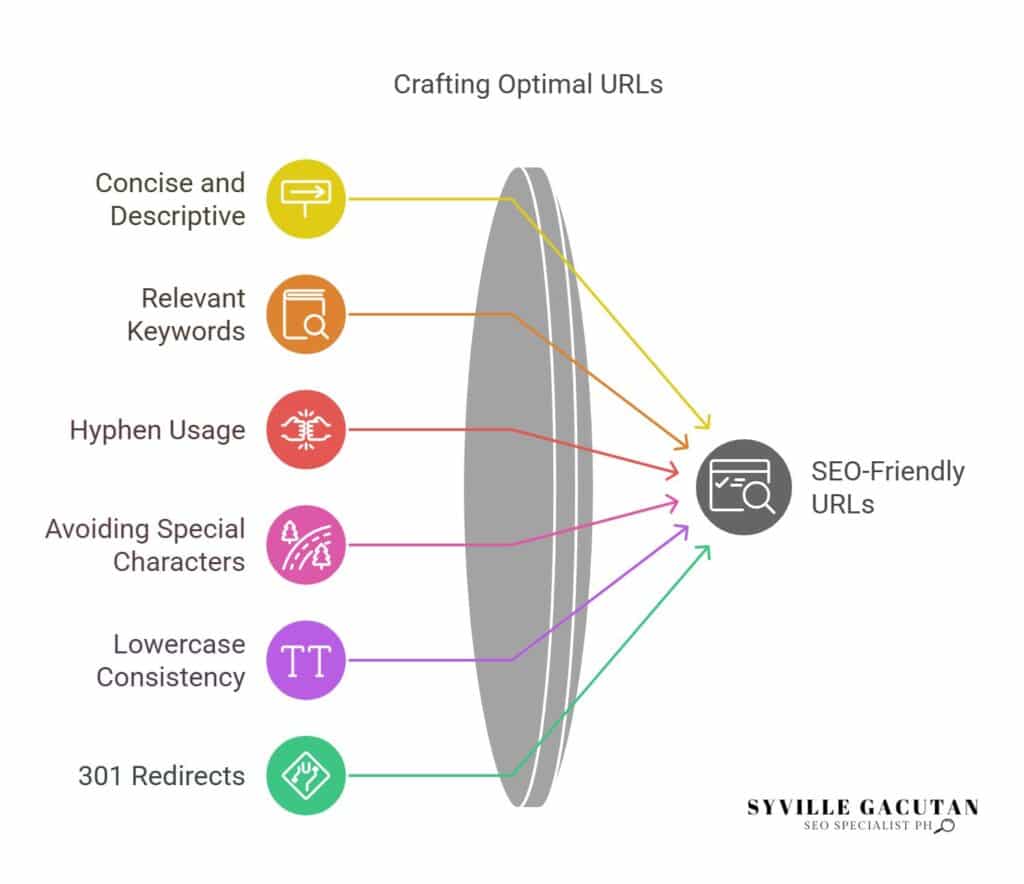
Creating SEO-friendly URLs is crucial for boosting your website’s visibility and improving user navigation. This begins with a well-structured URL that incorporates relevant keywords to help search engines and users understand your site’s content and hierarchy. Using hyphens to separate words and keeping URLs concise enhances readability and indexing. Refrain from stuffing URLs with excessive keywords. Also remove any unnecessary characters to ensure clarity. Employ lowercase letters to prevent duplicate content errors. Regular audits and using tools like Google Search Console can further optimize URL performance. To discover more about enhancing your website’s SEO potential, explore further insights and strategies.
Key Takeaways
- SEO-friendly URLs should be concise, descriptive, and incorporate relevant keywords for better search engine ranking.
- Use hyphens to separate words in URLs to enhance readability for both users and search engines.
- Avoid special characters and stop words in URLs to maintain simplicity and clarity.
- Consistently use lowercase letters to prevent case sensitivity issues and ensure uniformity.
- Implement 301 redirects for any URL changes to preserve the SEO value and maintain traffic.

Understanding SEO Basics

Grasping the fundamentals of Search Engine Optimization (SEO) is essential for enhancing online visibility and driving organic traffic to your website. Good SEO requires making URLs that search engines understand easily. These URLs impact how search engines rank your web pages. An optimal url structure is not only user-friendly but also aids search engines in understanding a page’s content and relevance.
To achieve seo-friendly URLs, it is crucial to incorporate relevant keywords in your URL. Engaging in this activity assists search engines in distinguishing the primary subjects of your webpage directly influencing the visibility of your site in search results. For instance, a URL that includes targeted keywords is more likely to rank higher than one with generic or unrelated terms. However, it is important to avoid overstuffing URLs with keywords, as this can lead to a negative impact on both user experience and search engine rankings.
Adhering to best practices for url creation is fundamental in the broader context of search engine optimization. A well-structured URL should be concise, descriptive, and free of unnecessary parameters or complex strings. This simplicity not only improves user readability but also facilitates easier indexing by search engines.
Moreover, using hyphens to separate words in a URL enhances clarity and prevents misinterpretation by both users and search engines.
Ultimately, understanding these foundational SEO principles empowers website owners to construct URLs that effectively contribute to their overall search engine optimization strategy, enhancing their potential to attract and retain a targeted audience.
Importance of URL Structure
A well-crafted URL structure serves as a critical component of an effective SEO strategy, directly influencing both search engine rankings and user experience. The importance of URL structure is often underestimated, yet it plays a pivotal role in communicating the content’s relevance to both search engines and users.
An seo-friendly url structure helps search engines understand the context and hierarchy of your site, ensuring that the most pertinent pages are prioritized and indexed efficiently. Moreover, a thoughtfully designed URL enhances user experience by making navigation intuitive and straightforward.
Incorporating keywords in the url is another essential aspect, as it provides a clear indication of the page’s content, thus improving its visibility in search results. Descriptive urls that reflect the content accurately also encourage higher click-through rates, as users are more likely to visit a page that clearly aligns with their search intent.
Consider the following reasons why url structure is crucial:
- Enhanced Crawling: Search engines can crawl and index pages more effectively.
- Better User Navigation: Users can easily understand and predict the content of the page.
- Increased Click-Through Rates: Clear and concise URLs attract more clicks.
- Improved Keyword Relevance: Including relevant keywords boosts search engine visibility.
- Consistent Site Architecture: A logical structure supports site expansion and content management.
Key Elements of SEO-Friendly URLs

To create SEO-friendly URLs, several key elements must be considered to ensure both search engines and users can easily interpret and navigate your site. A well-structured URL is integral to enhancing user experience and improving search engine rankings.
The first element to focus on is including relevant keywords in URLs. Keywords not only provide context to search engines about the page content but also make it more intuitive for users to understand what the page is about before clicking.
Another critical aspect is the structure of the URL itself. An optimized URL should be concise and straightforward, avoiding unnecessary parameters or complex strings that could confuse users and search engines. Aim for a clean structure where the hierarchy of the site is visible within the URL, which helps search engines index your pages more effectively and improves navigation for users.
Furthermore, readability is vital when crafting SEO-friendly URLs. Using hyphens to separate words instead of underscores or spaces improves clarity, as search engines treat hyphens as spaces, making it easier to parse the keywords. This small adjustment can significantly impact how URLs are perceived by both users and search engines.
Consistency in URL structure across the website fosters a better user experience. Maintaining uniformity in naming conventions and folder structures helps users and search engines anticipate the type of content found within different sections of the site.
Ultimately, these elements of SEO-friendly URLs contribute to a seamless user experience and a more efficient path for search engines to crawl and index your website’s content, enhancing its overall visibility.
Best Practices for URL Optimization

Effectively optimizing URLs is crucial for enhancing both search engine rankings and user experience. When endeavoring to create SEO-friendly URLs, adhering to best practices ensures that your content is easily accessible and understandable for both users and search engines. The structure helps search engines efficiently index and rank your pages, ultimately driving more traffic to your site.
One of the best practices for optimizing URLs is using keywords in the URL. Incorporating relevant keywords not only makes the URL more descriptive but also signals to search engines the content of the page. However, it is essential to maintain a balance, ensuring the URL remains concise and readable.
Here are some vital considerations when structuring your URLs:
- Simplicity and Clarity: Keep URLs straightforward and easy to read. Avoid unnecessary complexity or jargon that might confuse users or search engines.
- Use Hyphens for Separation: Hyphens are preferred over underscores for separating words, as they are more easily recognized by search engines.
- Lowercase Letters: Use lowercase letters to prevent potential issues with case sensitivity, which can lead to duplicate content concerns.
- Short and Descriptive: Aim to create URLs that are neither too lengthy nor overly generic. They should succinctly capture the essence of the page’s content.
- Avoid Stop Words: Words like “and,” “the,” and “of” can often be omitted without losing meaning, which streamlines the URL.
Common Mistakes to Avoid

Crafting SEO-friendly URLs involves navigating several common pitfalls that can hinder both search engine performance and user experience. One of the most prevalent mistakes is using dynamically generated URLs that contain long strings of numbers or special characters. Such URLs are challenging for both search engines and users to interpret, which can negatively impact your search engine ranking.
Instead, strive to keep your URLs simple, descriptive, and static, ensuring they reflect the content of the page concisely.
Another common mistake is failing to incorporate relevant keywords into your URLs. Keywords play a crucial role in optimizing your URLs for search engines. Including targeted keywords helps search engines understand the page’s relevance to specific queries, thereby improving your visibility.
However, overstuffing URLs with keywords can have the opposite effect, leading to penalties. Balance is key—integrate keywords naturally without compromising readability.
Long URLs can also be detrimental to SEO efforts. Lengthy URLs are not only cumbersome for users to share but can also get truncated in search results, potentially obscuring important information. Aim to keep your URLs concise, ideally under 60 characters, while maintaining clarity and relevance.
Additionally, neglecting to use hyphens to separate words is another misstep. Hyphens improve the readability of URLs for both humans and search engines. Avoid underscores and spaces, as they can lead to confusion and hinder indexing.
Tools for Analyzing URLs

When optimizing your website for search engines, leveraging the right tools for analyzing URLs can significantly enhance your SEO strategy. A well-structured, seo-friendly URL slug not only improves the aesthetic and navigational experience for users but also plays a crucial role in boosting your visibility on search engine results pages.
By utilizing tools designed to analyze URLs, you can ensure that your site is effectively structured to attract and retain traffic to your website.
Several reliable tools are available to assist in this vital aspect of SEO:
- Google Search Console: This tool provides insights into how Google views your site and offers reports on URL performance, helping you identify areas for optimization.
- Ahrefs: Known for its comprehensive SEO analysis capabilities, Ahrefs allows you to inspect URLs and gain insights into backlinks, which can benefit your SEO efforts.
- Screaming Frog SEO Spider: This tool crawls your website and highlights issues with URL slugs, such as those that are too long or contain unnecessary parameters.
- Moz Link Explorer: Offering detailed reports on link metrics, this tool aids in evaluating the authority and potential of your URLs to attract organic traffic.
- SEMrush: With features that analyze URL performance and competitiveness, SEMrush helps you refine your strategy to improve search engine rankings.
These tools are integral to creating and maintaining an SEO-friendly URL structure. They enable you to analyze URLs effectively, ensuring that each is optimized to support your overall SEO objectives.
Implementing URL Changes Safely
After utilizing the appropriate tools to analyze and optimize your URLs, the next step is to implement changes to your website safely. When it comes to implementing URL changes safely, meticulous planning and careful execution are crucial. Changing a URL is not merely a technical endeavor; it impacts user experience, search engine rankings, and overall site functionality. Thus, understanding the steps involved in updating URLs while keeping them SEO-friendly is essential.
Firstly, ensure you have a comprehensive list of URLs that require modification. Prioritize these changes based on their impact on SEO and user engagement. As you update the URL structure, maintain consistency and clarity to enhance readability and indexing by search engines. Aim for concise URLs that accurately reflect the content’s nature.
Before executing changes, it is advisable to create a backup of your website. This precautionary step safeguards against potential data loss or disruptions during the transition.
When you change a URL, employ 301 redirects to preserve the SEO value of the original URLs. This ensures that users and search engines are directed to the new URL seamlessly.
Furthermore, update internal links to reflect the new URL paths, ensuring that users can navigate your site without encountering broken links. Keeping your URLs updated requires collaboration with your development team to test the new structure thoroughly.
Verify that all redirects function correctly, and monitor site performance to identify any anomalies.
Monitoring URL Performance

Monitoring URL performance is a critical component of maintaining an SEO-friendly website. By closely examining how your URLs are performing, you can ensure they are enhancing rather than hindering your site’s visibility and search engine rankings.
SEO performance is significantly influenced by the structure and organization of your URLs, making it essential to assess and optimize them regularly.
To make your URL strategy effective, consider these key aspects:
- Analyze Traffic Patterns: Regularly review traffic data to identify which URLs are driving the most visitors and which are underperforming.
- Evaluate Engagement Metrics: Measure user engagement metrics such as bounce rate, time on page, and conversion rates to understand how well-structured URLs are impacting user experience.
- Monitor Indexing Status: Ensure that all important URLs are being indexed by search engines. Use tools like Google Search Console to track indexing issues and rectify them promptly.
- Assess Dynamic URLs: Keep an eye on dynamic URLs, as they can sometimes lead to duplicate content issues if not properly managed.
- Track Changes Over Time: Document changes to your URLs and monitor their impact over time to understand what strategies are most effective.
Final Thoughts
Creating SEO-friendly URLs is a simple yet effective strategy for improving your website’s visibility and user experience. By keeping URLs concise, incorporating relevant keywords, and ensuring they are free from unnecessary characters, you can enhance both search engine rankings and usability. Regularly auditing your URLs and using tools like Google Search Console will help maintain their effectiveness over time.
If you’re looking to optimize your URLs and boost your website’s SEO performance, Syville Gacutan, an experienced SEO Specialist in the Philippines, can help. With expertise in crafting SEO-friendly URLs, enhancing website structure, and improving search engine rankings, Syville ensures your site is fully optimized for visibility and user experience. Connect with Syville today and elevate your website’s SEO strategy.